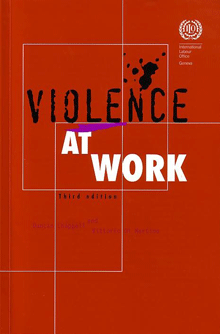ILO and Workers: Violence at Work
 The International Labour Organization (ILO) was founded in 1919 to promote social justice and, thereby, to contribute to universal and lasting peace. Its tripartite structure is unique among agencies affiliated to the United Nations. The ILO’s Governing Body includes representatives of government, employers’ and workers’ organizations. Its International Labour Conference meets annually to discuss social and labour questions.
The International Labour Organization (ILO) was founded in 1919 to promote social justice and, thereby, to contribute to universal and lasting peace. Its tripartite structure is unique among agencies affiliated to the United Nations. The ILO’s Governing Body includes representatives of government, employers’ and workers’ organizations. Its International Labour Conference meets annually to discuss social and labour questions.
As part of its work, the ILO provides expert advice and technical assistance to member States through a network of offices and multidisciplinary teams in over forty countries. This assistance takes the form of labour rights and industrial relations, counselling, employment promotion, training in small business development, project management, advice on social security, workplace safety and working conditions, the compiling and dissemination of labour statistics, and workers’ education.
The International Labour Office is the Organization’s secretariat, research body and publishing house. It produces material on major social and economic trends, publishes policy statements on issues affecting labour around the world, reference works, technical guides, research books and monographs, codes of practice prepared by experts and training and workers’ education manuals.
Violence at Work
The ILO has been in the vanguard in addressing protection of workers’ dignity and equality in the workplace, including publications on occupational stress, sexual harassment and child labour, among others. The commitment of the ILO to reducing workplace violence is demonstrated through the publication, in 2004, of its code of practice Workplace violence in service sectors and measures to combat this phenomenon.
A third edition of an ILO publication Violence at Work was published in 2006. It is structured in three parts: I Understanding Violence at work, II Responding to Violence at work, III Future action. It examines the full range of aggressive acts that occur in workplaces including homicides, assaults, sexual harassment, threats, bullying, mobbing and verbal abuse. It offers new information and evidence about the incidence and severity of workplace violence in countries around the world, including examination of some terrorist and mass murder events, identifies occupations and situations at particular risk, evaluates various causal explanations and details some of the social and economic costs.
It evaluates the effectiveness of workplace anti-violence measures and responses such as regulatory innovations, policy interventions, workplace design that may reduce risks, collective agreements and various “best practice” options worldwide. An expanded chapter deals with national and international legislation, and best practices, including from the European Union.
Viewed as a groundbreaking publication, Violence at Work is directed toward all those engaged in combating violence at work: policy makers in government agencies, employers’ and workers’ organizations, occupational safety and health professionals, human resources managers, trainers and workers. It is intended to promote dialogue, policies and initiatives “to repudiate violence and remove it from the workplace now”.
To mark Labour Day on l May 2007 - in celebration for the world’s workers - removal of workplace violence might be a hard but not an impossible challenge to face in the twenty-first century.
Ita Marguet
Source: Violence at Work, Third edition, Geneva, International Labour Office, 2006. (360 pages including Bibliography and Index). ISBN 92-2-117948-6 / 978-92-2-117948-1. Price 30 Swiss Francs.


